Physical Address
304 North Cardinal St.
Dorchester Center, MA 02124
3.1
3.2
3.3
3.4
Visit Expert Consult ( expertconsult.inkling.com ) for videos on topics discussed throughout the text.
Ectropion of the eyelid occurs when the lid margin everts or turns away from the eyeball. Lower lid ectropion is a common problem. Patients may complain of irritation or mattering , erythema of the lid margin , or tearing. Three types of lower lid ectropion occur:
Cicatricial
Paralytic
Involutional
Cicatricial ectropion is caused by shortening of the anterior lamella as a result of trauma, medication, or cicatricial skin disease. Shrinking of the skin of the front of the eyelid pulls the eyelid off the eye. Involutional ectropion is caused by horizontal laxity of the eyelid. The lower eyelid is too long or loose and it falls away from the eye. Paralytic ectropion is caused by loss of orbicularis muscle tone, which supports the lower eyelid in its normal position. Associated lower facial paralysis and brow ptosis usually accompany paralytic ectropion. The type and cause of the ectropion are usually obvious from the history and examination. Often, there is more than one etiology of the ectropion occurring simultaneously. For example, facial nerve palsy in a young patient without lid laxity often does not cause ectropion. In an older patient, with preexisting horizontal laxity, the eyelid is ectropic.
After the etiology of the ectropion is identified, a treatment plan can be made. The lateral tarsal strip operation is used to correct horizontal lid laxity. The lower eyelid is shortened at the lateral canthus. This operation is the procedure of choice for repairing involutional eyelid ectropion. Paralytic ectropion is usually treated with the operation, also. Some version of the lateral tarsal strip procedure is probably the most useful operation to learn in all of oculoplastic surgery. In severe cases of ectropion, sutures supporting the cheek may also be required (i.e., a midface lift) to prevent the lid from sagging. Paralytic ectropion is somewhat more complicated to treat than involutional ectropion because corneal exposure and brow ptosis may also require treatment.
Cicatricial ectropion is treated by lengthening the shortened anterior lamella, usually with a full-thickness skin graft . Frequently, a lateral tarsal strip operation is used in conjunction with a full-thickness skin graft to treat any associated lid laxity. Cicatricial ectropion of the upper eyelid may also occur. There is no upper eyelid equivalent for paralytic or involutional ectropion.
Congenital ectropion or eversion of the upper or lower eyelid can occur but is extremely rare. Some texts include a mechanical form of ectropion. This is said to occur when a large tumor forms on the eyelid, pulling the eyelid off the eye. I consider this to be more of a tumor problem than a lid malposition and so have not included discussion of a mechanical ectropion in this chapter. Irritation and mattering can occur if the upper eyelid is extremely lax. This is known as floppy eyelid syndrome . It may be caused by poor eyelid apposition or eversion of the eyelid during sleep. Floppy eyelid syndrome is discussed later in the section on physical examination.
Ectropion is common and easy to diagnose. The mechanisms are understandable, and the cause is recognizable during the history and physical examination. Appropriate treatment can be chosen based on the type of ectropion identified. Surgical correction is successful in most cases.
The normal lower lid rests at the limbus ( Figure 3.1 ; also see Figure 2.1 in Chapter 2 ). There is normally no sclera visible between the lower lid margin and the limbus. The lower eyelid apposes the eye for the entire length of the eyelid. There should be no separation of the posterior lid margin from the eye. In most Caucasian eyelids, the lateral canthus is slightly higher than the medial canthus. Some racial variations occur. The lower lid punctum sits in the tear lake at the conjunctival plica. The next time you look at a patient with the slit lamp, notice that the normally positioned punctum is not visible at the slit lamp without using your finger to slightly evert the punctum. Normal tear drainage will not occur if the punctum is vertical or upright. The normal tear lake should be approximately 0.5 mm high. You will see examples of excessive and inadequate tear lakes during your slit lamp examination.
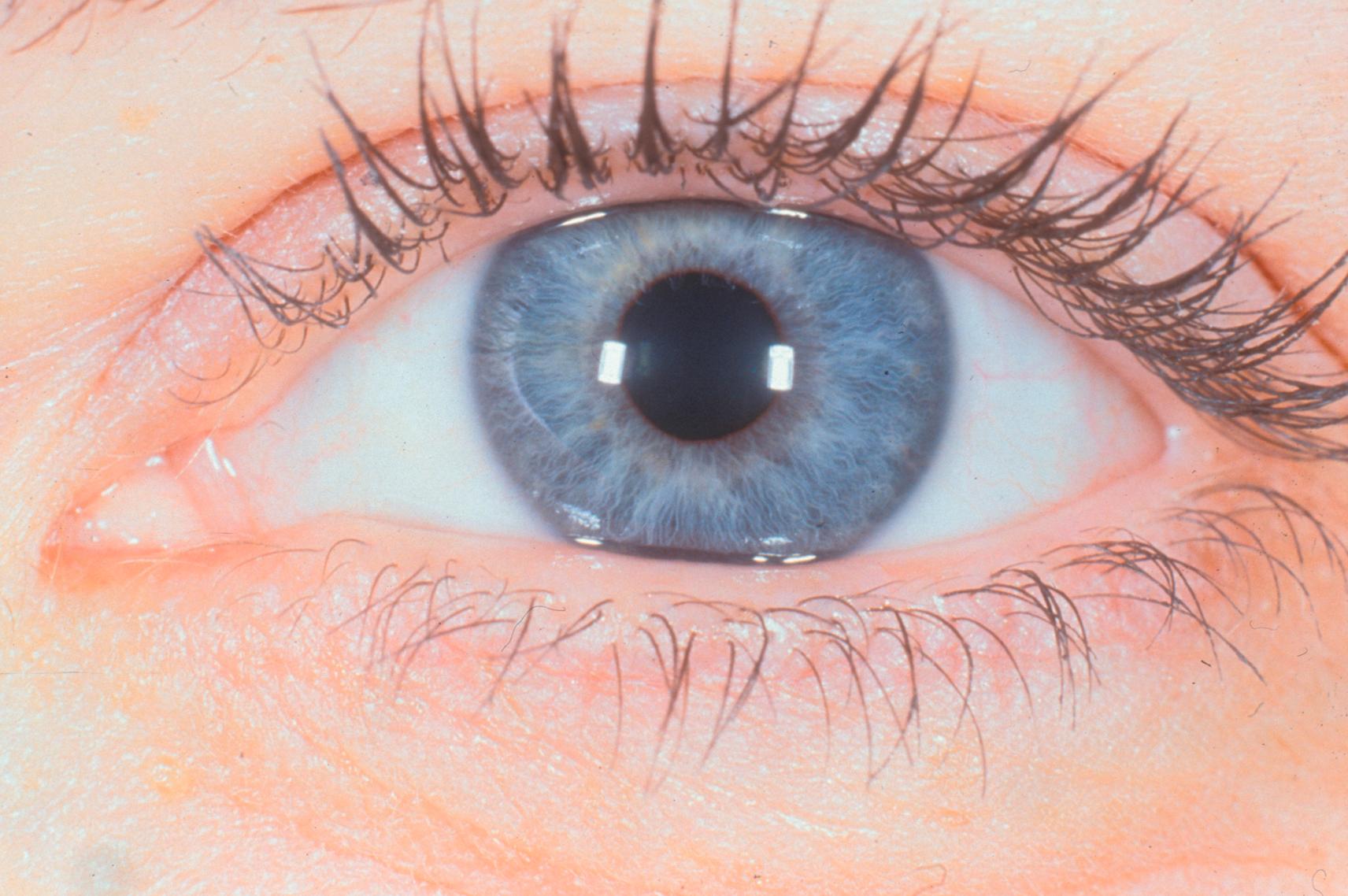
The tarsal plates are attached to the bony orbital rims by the lateral and medial canthal tendons. Lengthening of the tendons occurs with age. This increase in the horizontal length of the eyelid is responsible for the eyelid laxity that causes involutional ectropion. The tarsal plates do not lengthen with time. The insertion of the lateral canthal tendon is on the inner aspect of the lateral orbital rim at the Whitnall tubercle. This slightly elevated area of the lateral orbital rim is approximately 10 mm inferior to the frontozygomatic suture. When you reattach the lateral canthal tendon using the lateral tarsal strip procedure, reposition the tendon on the inner aspect of the rim to prevent lid distraction from the globe.
The bony architecture of the inferior orbital rim provides support for the lower eyelid. Individual and racial variations occur. Patients with higher cheekbones or prominent malar bones tend to have less ectropion. Asian patients tend to have a flat face with more prominent malar bones. Black patients tend to have less prominent malar bones. The bony architecture of Caucasian patients is intermediate. Patients with the so-called hypoplastic midface or maxilla have an inferior orbital rim that is somewhat posterior in relationship to the eyeball ( Figure 3.2 ). These patients tend to have less support for the lower lid and often have a low resting lower eyelid position. These patients are more susceptible to ectropion and further lower eyelid retraction. Another term for the hypoplastic maxilla is hemiproptosis . I like this term because it emphasizes the fact that the inferior half of the eye is more anterior than the orbital rim. Tightening of the lower lid in a patient with hemiproptosis may cause the eyelid to slide under the eye, creating lower eyelid retraction. Be careful when tightening any lower eyelid in a patient with hemiproptosis. The relationship of the maxilla to the inferior rim should be considered in patients undergoing lower eyelid blepharoplasty in order to avoid the complication of eyelid retraction or “rounding” of the lower eyelid. You will see later that hemiproptosis is also referred to as a negative vector eyelid , especially in the context of lower eyelid cosmetic surgery. Patients with a negative vector eyelid are prone to lower eyelid retraction after lower blepharoplasty.
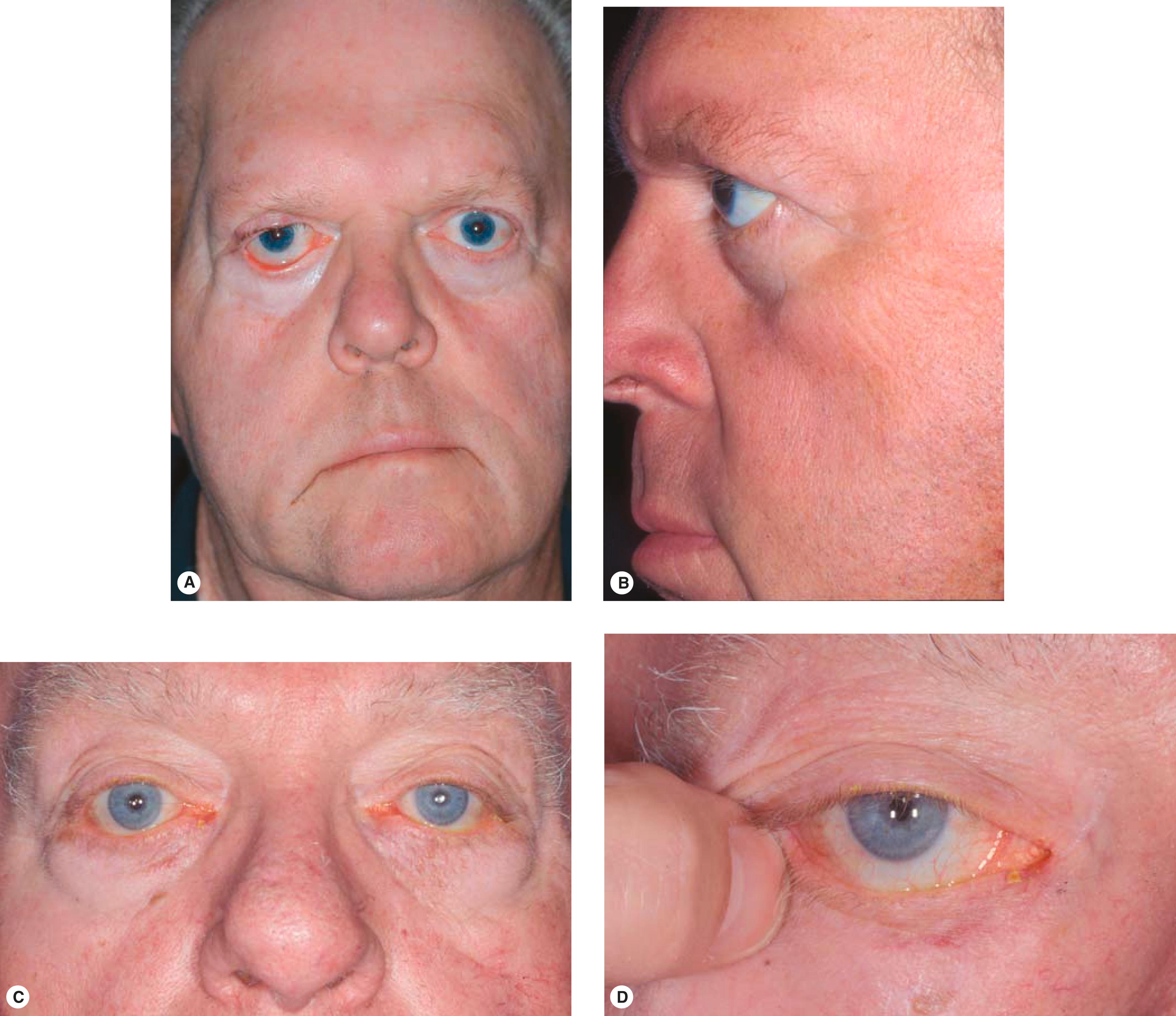
The skin, orbicularis muscle, and orbital septum are normally flexible enough that quick spontaneous movements of the eyelids can occur. You are already familiar with the terms anterior lamella (skin and muscle) and posterior lamella (tarsus and conjunctiva). Shortening of the anterior lamella can cause a cicatricial ectropion ( Figure 3.3 ). Lengthening of the shortened lamella by medical treatment or adding a full-thickness skin graft is the treatment for cicatricial ectropion . As you know, scarring of the posterior lamella also causes a cicatricial entropion.
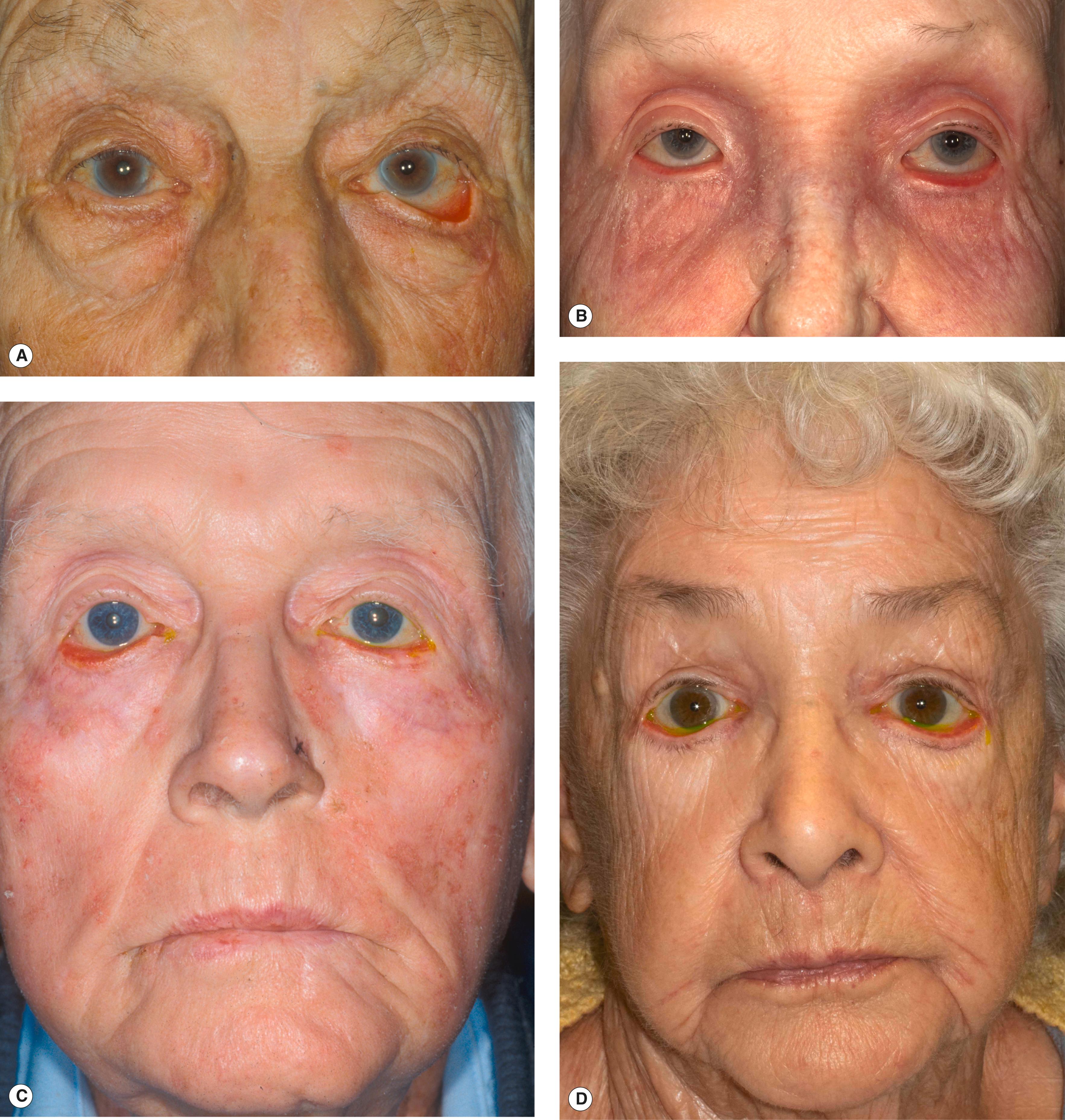
The term middle lamella has been used to describe the tissues between the anterior and posterior lamellae of the eyelid inferior to the tarsal plate. These tissues include the orbital septum, preaponeurotic fat, and lower lid retractors. Scarring of the middle lamella may tether the eyelid, which causes cicatricial ectropion, lid retraction, or even cicatricial entropion, depending on how the scar tissue forms. This middle lamella scarring occurs most commonly after eyelid trauma or surgery. There is no middle lamella in the pretarsal portion of the eyelid.
The resting tone of the orbicularis muscle supports the tarsal plate and canthal tendons, helping to support the lower eyelid in the normal position. In patients with paralytic ectropion, the resting tone of the orbicularis muscle is reduced or absent ( Figure 3.4 ). Ectropion occurs primarily in older patients who have an underlying element of lid laxity. In younger patients with facial nerve palsy, ectropion generally does not occur, because there is no underlying lid laxity.
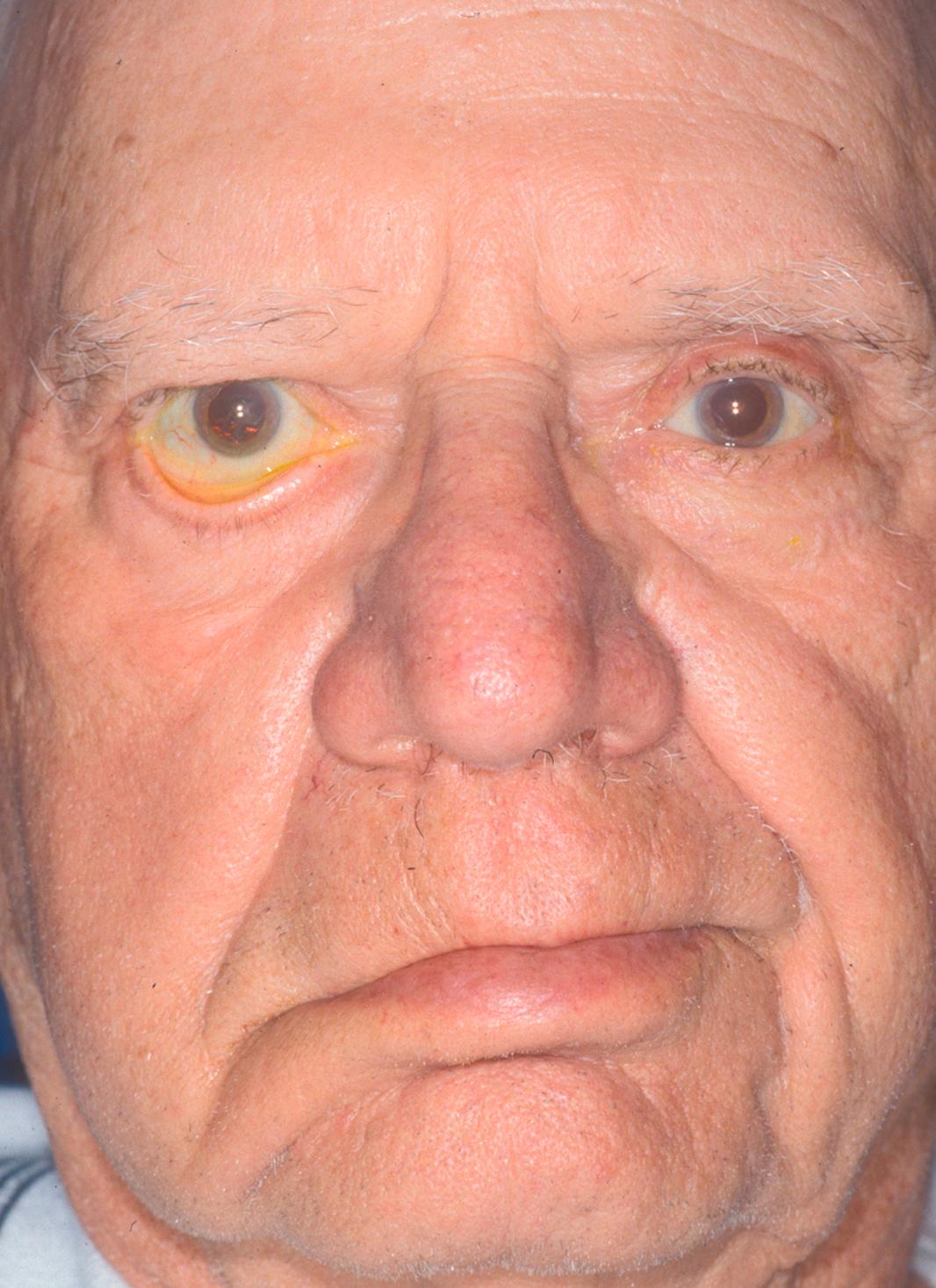
Normal lid position and function are necessary for tear drainage. Any type of ectropion may cause tearing as a result of corneal exposure, with resultant reflex tearing, punctal eversion, or loss of the lacrimal pump. Interestingly, many older patients with ectropion do not complain of tearing. This is probably because tear production decreases with age.
At this point you should:
Know the types of ectropion
State the anatomic cause for each type of ectropion
Explain the term hemiproptosis. What are other terms for this condition?
Understand why younger patients with facial nerve palsy may not have ectropion
Understand the reasons for tearing resulting from ectropion
The history in ectropion is straightforward. You want to understand what bothers the patient about the ectropion. Patients with ectropion usually complain of irritation , redness , or tearing . As the lower eyelid everts, the normally moist conjunctival tissues become exposed to air and dry out. The conjunctiva becomes erythematous. A discharge may develop. The irritation is usually mild, and some patients may choose to ignore recommended treatment for the ectropion. This is in contrast to patients with entropion. When the eyelashes rub against the eye, the irritation is more severe, and patients seldom refuse treatment. For some patients, the main complaint about the ectropion is the erythematous appearance of the lid margin. Tearing may accompany the ectropion. The cause of tearing may be reflex, punctal malposition, or inadequate lacrimal pump function. Younger patients make more tears than older patients. As you would expect then, tearing is more severe in young patients than in older patients. A young patient with mild punctal eversion may complain of severe tearing with tears rolling down the cheek (epiphora), whereas an older patient with complete ectropion may have no complaints related to watering. If tearing is present, you need to pay particular attention to the position of the punctum when you are correcting the eyelid position.
A history of trauma or cicatricial skin disease may explain why a patient has cicatricial ectropion . Previous excision of skin cancer or repair of a laceration in the periocular area may cause anterior lamellar shortening. The most common cause of anterior lamellar shortening is actinic damage in fair-skinned Caucasian patients. These patients have far fewer wrinkles than expected for their age (you cannot have wrinkles without some laxity). Rarely, a patient may have a cicatricial skin disease, such as ichthyosis, that may cause the eyelid skin to shorten. Eye medications can result in a contact dermatitis with shrinkage of the skin and ectropion. This is common with glaucoma drops. Changing glaucoma medications often improves the dermatitis and cures the ectropion.
Even a patient who has no obvious facial asymmetry may recollect a resolved Bell palsy . This mild orbicularis weakness may combine with horizontal laxity to cause paralytic ectropion .
The purpose of the physical examination is to identify the presence, location, and severity of the ectropion, as well as the underlying etiology. Any eversion of the lid margin off the eyeball is considered ectropion. The lid distraction may be mild and relatively asymptomatic. Only the punctum may be everted, with tearing as the complaint rather than ectropion. The ectropion may be lateral or medial or involve the entire lower eyelid. The ectropion may be severe with the entire lid everted to the degree that the eyelid is turned inside out. This condition is known as tarsal ectropion ( Figure 3.5 ).
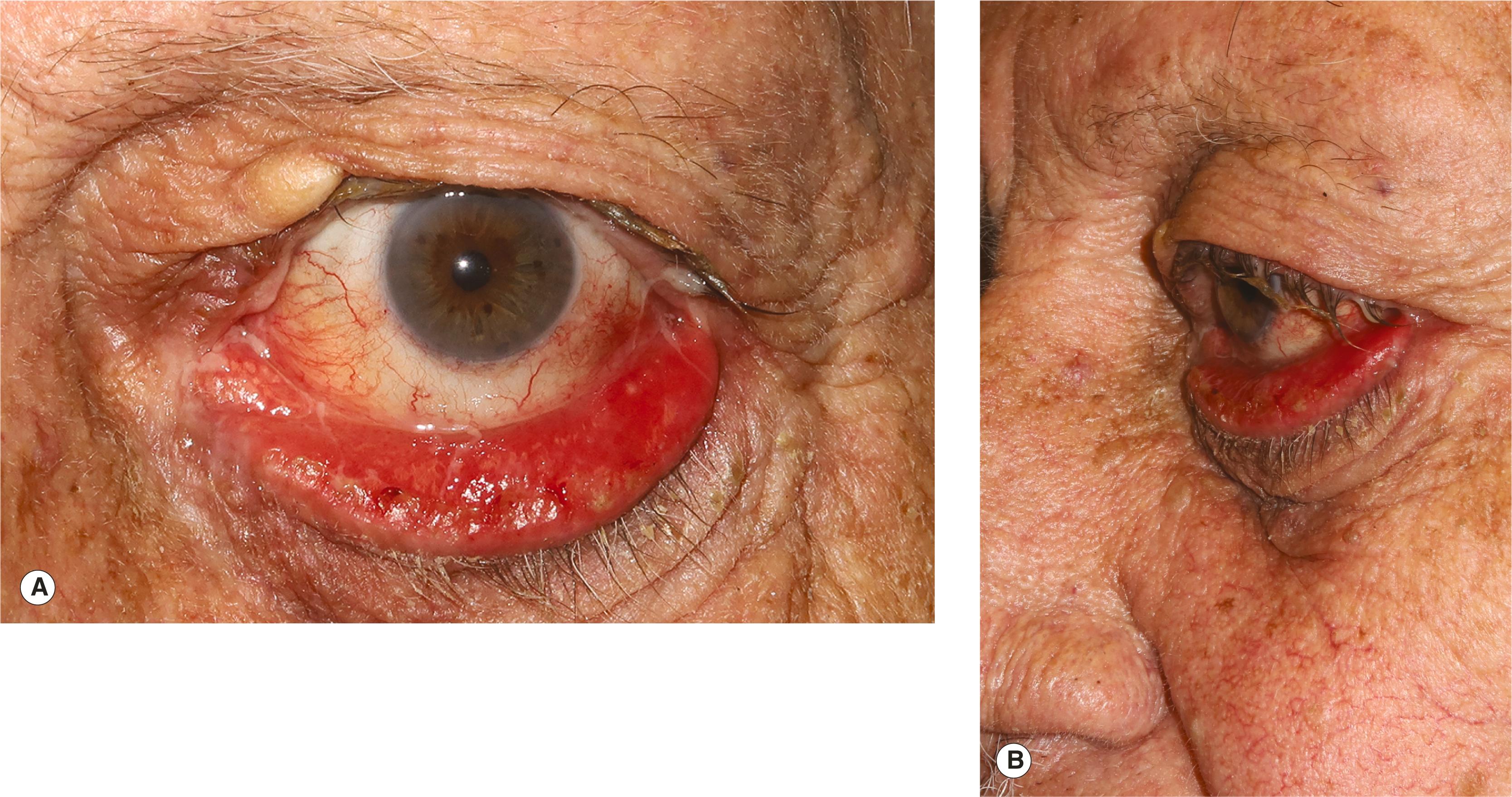
Become a Clinical Tree membership for Full access and enjoy Unlimited articles
If you are a member. Log in here